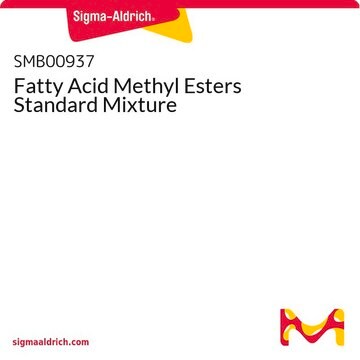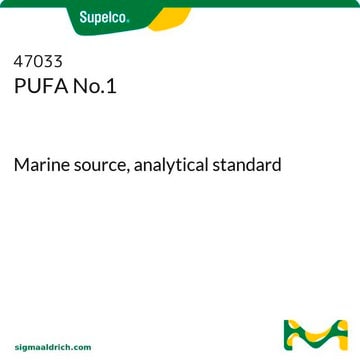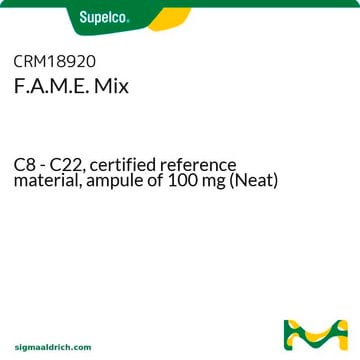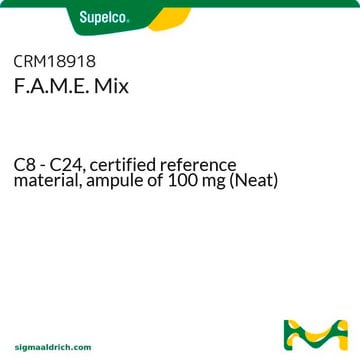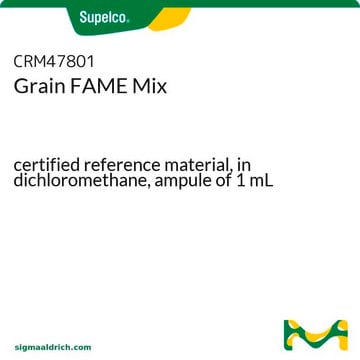47080-U
Bacterial Acid Methyl Ester (BAME) Mix
solution (10 mg/mL total concentration in methyl caproate), analytical standard
Sign Into View Organizational & Contract Pricing
All Photos(1)
About This Item
Recommended Products
grade
analytical standard
form
solution (10 mg/mL total concentration in methyl caproate)
CofA
current certificate can be downloaded
packaging
ampule of 1 mL
technique(s)
HPLC: suitable
gas chromatography (GC): suitable
application(s)
food and beverages
format
multi-component solution
storage temp.
-10 to -25°C
Related Categories
General description
This is a qualitative standard of bacterial acid methyl esters in methyl caproate (10 mg/mL total concentration). Use this mix to distinguish between various bacteria on the basis of their cellular fatty acid composition. For information on the chromatographic analysis of this standard, please contact Technical Services at techservice@sial.com.
Check out our complete portfolio of Fatty acid methyl ester (FAME) reference material solution mixes
Check out our complete portfolio of Fatty acid methyl ester (FAME) reference material solution mixes
Application
The analytical standard can be used as follows:
- Development of a method to identify bacteria based on the gas chromatographic-vacuum ultraviolet spectroscopic (GC-VUV) analysis of bacterial fatty acid methyl esters (FAMEs)
- Fatty acid methyl ester (FAME) profiling of biodiesel obtained from microbial oil after its transesterification by gas chromatography-mass spectrometry (GC-MS)
- GC-FID method-based separation and determination of fatty acid methyl esters (FAMEs) in the lipid extracts of leptocephalus larva of eels
Other Notes
Refer to the product′s Certificate of Analysis for more information on a suitable instrument technique. Contact Technical Service for further support.
Analyte
Description
Methyl undecanoate
Methyl (±)-2-hydroxydecanoate
Methyl dodecanoate
Methyl tridecanoate
Methyl 2-hydroxydodecanoate
Methyl (±)-3-hydroxydodecanoate
Methyl myristate
Methyl 13-methyltetradecanoate
Methyl 12-methyltetradecanoate
Methyl pentadecanoate
Methyl 2-hydroxytetradecanoate
Methyl 3-hydroxytetradecanoate
Methyl 14-methylpentadecanoate
Methyl cis-9-hexadecenoate
Methyl palmitate
Methyl 15-methylhexadecanoate
Methyl cis-9,10-methylenehexadecanoate
Methyl heptadecanoate
Methyl 2-hydroxyhexadecanoate
Methyl linoleate
Methyl oleate
Methyl trans-9-octadecenoate
Methyl stearate
Methyl methyleneoctadecanoate (all cis-9,10)
Methyl nonadecanoate
Methyl eicosenoate
See All (26)
Application
related product
Product No.
Description
Pricing
Signal Word
Warning
Hazard Statements
Precautionary Statements
Hazard Classifications
Flam. Liq. 3
Storage Class Code
3 - Flammable liquids
WGK
WGK 3
Flash Point(F)
109.4 °F - closed cup
Flash Point(C)
43 °C - closed cup
Personal Protective Equipment
dust mask type N95 (US), Eyeshields, Gloves
Choose from one of the most recent versions:
Already Own This Product?
Find documentation for the products that you have recently purchased in the Document Library.
Customers Also Viewed
Maryn O Carlson et al.
G3 (Bethesda, Md.), 9(9), 2963-2975 (2019-07-13)
Oat (Avena sativa L.) has a high concentration of oils, comprised primarily of healthful unsaturated oleic and linoleic fatty acids. To accelerate oat plant breeding efforts, we sought to identify loci associated with variation in fatty acid composition, defined as
Nadine Ebm et al.
Hydrobiologia, 848(2), 371-383 (2020-12-22)
The River Continuum Concept implies that consumers in headwater streams have greater dietary access to terrestrial basal resources, but recent studies have highlighted the dietary importance of high-quality algae. Algae provide consumers with physiologically important omega-3 (n-3) polyunsaturated fatty acids
J Dherbécourt et al.
Journal of applied microbiology, 105(4), 977-985 (2008-05-01)
Short branched-chain fatty acids (BCFAs) are cheese flavour compounds, which result from the conversion of branched-chain amino acids (BCAAs). In Swiss cheese, the production of short BCFAs is mainly performed by Propionibacterium freudenreichii and is strain dependent. Our aim was
Graciete S Silva et al.
Indian journal of microbiology, 57(3), 351-358 (2017-09-15)
The conditions of storage, cultivation and maintenance of microbial cultures should preserve the microbiological homogeneity, phenotypic and genotypic characteristics to ensure better reproducibility of metabolic production. To evaluate the influence of the storage condition on the composition of cell fatty
L E Koch et al.
Journal of dairy science, 102(6), 5079-5093 (2019-04-15)
Diet-induced milk fat depression (MFD) is a multifactorial disorder that can be triggered by a variety of conditions. Feeding high amounts of starch and unsaturated fatty acids has been shown to reduce milk fat yield and composition, as well as
Protocols
Protocol for GC Analysis of Bacterial Acid Methyl Esters (BAMEs) on Equity®-1
Chromatograms
suitable for GCsuitable for GCOur team of scientists has experience in all areas of research including Life Science, Material Science, Chemical Synthesis, Chromatography, Analytical and many others.
Contact Technical Service


